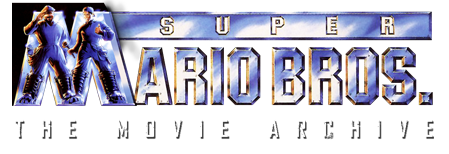Exclusive Interviews
Mike Criscuolo - SMB Archive Interview: 05/23/2011 by Steven Applebaum

The identities of the actors behind the film's dino-humans were long been considered lost information due to their uncredited roles. Even after uncovering Mark Jeffrey Miller as the "Lizard Man," it seemed unlikely for us to have the opportunity to speak to another.
Therefore, it was a great surprise to learn from our interview with Craig Edwards who another man behind the makeup was. This man, Michael Criscuolo, turned out to be not only the "Goomba Man" designed by Jeff Goodwin, but also an active production assistant and John Leguizamo's stand-in.
So, sit back and listen to another person that added something special to the world of Dinohattan! --Steven Applebaum
SA: Thank you for taking the time to do this interview, Michael. Could you start out by telling us a little bit about yourself and how you started acting?
MC: I come from a show business family. Everyone in my immediate family is involved in the arts in some way. My grandmother was a dance teacher and I spent summers as a kid hanging out at her dance studio. So, I was raised around many different aspects of the entertainment industry. It’s the family business.
I actually never intended to become an actor. When I was a kid, I wanted be a movie director like Steven Spielberg (Raiders of the Lost Ark and E.T. made BIG impressions on me). Or a pitcher for the Yankees. I auditioned for my first play as a goof (my junior high school’s production of Guys and Dolls) and got cast as one of the leads. And from there, I was off and running.
SA: Were you familiar with the Super Mario Bros. video games before becoming involved with the film? If not, did you take the time to look into them?
MC: I’d heard of the video game, for sure. But I’d never played it before, and I still haven’t. I did no background research before working on the movie. I just picked up tidbits along the way, whenever there was something in the script that everyone on the set seemed to know about except me.
SA: How did you first hear of the film and what made you want to audition?
MC: I first heard about it from my agent at the time, who told me that the Mario Bros. movie was on the horizon and would be coming to town to shoot. All I knew about it was that it was going to be a big Hollywood-type shoot with lots of special effects, and that the producers were aiming for a big summertime release the following year. And Bob Hoskins was in it. That all sounded good to me. I was going to jump at any chance I had to work with Bob Hoskins.
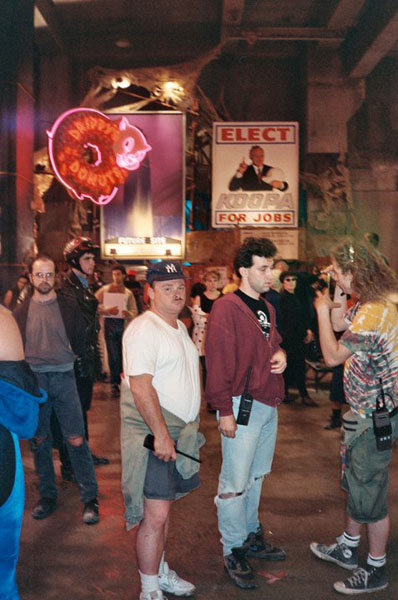
Mike along with Bob Hoskins...err...Bob Hoskins' stand-in
SA: Did you initially audition for the roles you received or were you aiming for something else?
MC: I honestly don’t remember which part I initially auditioned for. I just remember that a lot of my friends and colleagues got called in to read, so we all sort of went in together. I didn’t think my reading went particularly well, but I shrugged it off and pretty much forgot about it.
Cut to six weeks later, when my agent got a call from the casting director saying that I got the gig. They wanted me to play one of the dino-humans, which they told me was just basically going to be glorified extra work. But, because there was specialty makeup involved, I would get paid the SAG day player rate (which is significantly higher than the SAG extra rate) and shoot one or two days at the most.
However, they also wanted to use me as an on-set production assistant, which meant that I would be on the set every day and getting paid a separate salary for that position.
SA: Do you remember at what point in the production you came on and how long you worked on-set?
MC: I started working on the very first day of shooting: two days of location work a very short drive from where I lived at the time. The ideal way to start on a shoot that big. The initial shoot was scheduled for a little over two months, but we quickly fell behind schedule and ran over. I know the shoot ended up going at least four months, but I was only there for three.
SA: What were your duties as a production assistant? What do you feel your personal contribution to the finished film is?
MC: My duties pretty much entailed anything and everything. I made sure the actors knew when they had to be on set and when they could take a break. I had to relay information back and forth between departments. I had to help wrangle extras. I had to make sure the set was quiet and secure whenever we were shooting. And I had to interact with just about every single person on the set, because the P.A.s are the people the rest of the crew looks to for information on a daily basis.
It was a pretty high impact job. And whatever personal contribution I made to film, I hope it involved just helping to keep things as even-keeled as possible. A movie shoot can be volatile and unpredictable, and this one was definitely both.
One of the great things, though, was that I had already been on the set for a couple of months by the time I shot my scenes as a dino-human. So I didn’t feel out of place or have to adjust. I knew everyone already, and it was almost like a little vacation. I got a trailer, I got to eat first, and I didn’t have to do any P.A. work while I was doing my dino-human stint. So that was nice.
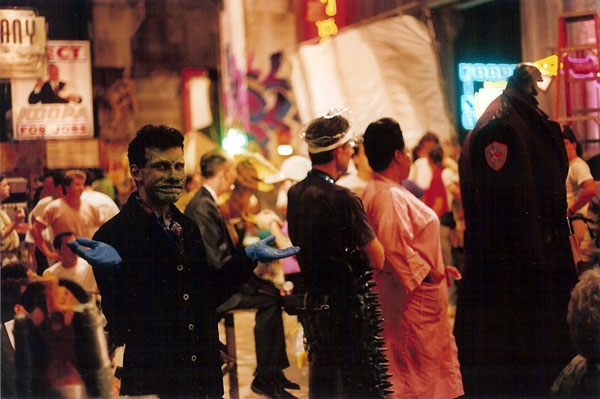
"A movie shoot can be volatile and unpredictable, and this one was definitely both."
SA: Which dino-human were you?
MC: I wasn’t a specific dino-human. I was just an extra in a big crowd scene at the end after Mario and Luigi have defeated Koopa. I actually got cut out the finished film, but I still get residuals. So that’s another perk of the whole thing.
SA: That scene is a great send-off for the film as lots of characters the Mario Bros. encountered during their adventure returned. What did they have you do during that celebration?
MC: I didn't have to do much of anything. I was placed in the crowd celebrating Koopa's demise, and I just had to... celebrate. Just like everyone else in that crowd scene. I wasn't featured or anything like that. Just one of the many dino-humans whooping and hollering.
SA: Who worked on your makeup as a dino-human?
MC: Jeff Goodwin and Vinny Guastini primarily worked on my makeup. They were great.
SA: What was the application and maintenance process for the makeup?
MC: They warned me ahead of time that the makeup took three hours to apply and they were not kidding. I had to sit very still the whole time and not fall asleep. Vinny helped keep me awake by blasting the radio during the whole process. On the flip side, taking all the makeup off only took an hour and was much easier.
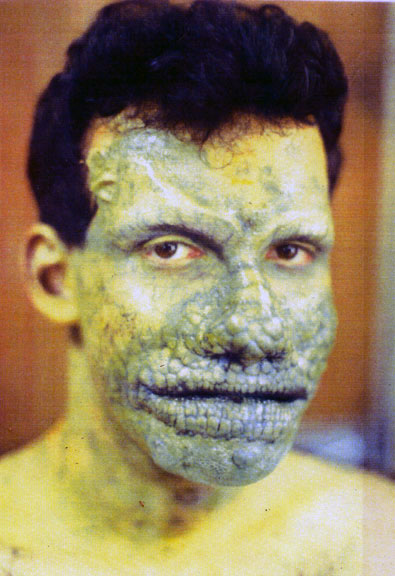
Mike after makeup application
SA: Did the makeup/prosthetics make you uncomfortable or hinder your performing abilities in any way?
MC: Not at all. The makeup was actually pretty comfortable and easy to wear. It was even somewhat manageable while eating, which is a true wonder. Jeff and Vinny really did a great job.
SA: Do you recall what kind of scenes you shot as that character and why they may have been cut?
MC: I have no idea why my part of the scene may have been cut except that it was probably not essential to the story in any way. And it’s not as if you would’ve been able to see me if they left me in, anyway. So I didn’t worry about it.
SA: Do you know if your appearance was inspired by any specific real-world reptiles or dinosaurs, or just a general "reptilian" concept?
MC: It seemed to be a general reptilian concept to me. If there was a more specific inspiration than that, I don’t know.
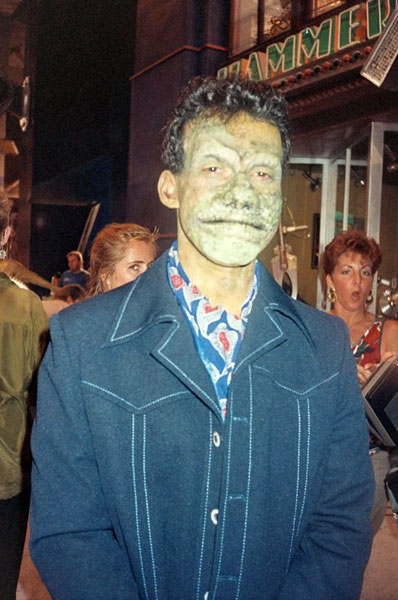
Vincent Guastini has told us that Mike's character was dubbed the "Goomba man"
SA: What was your interaction with the entire makeup crew and the other dino-human actors?
MC: It was pretty extensive thanks to my P.A. duties. I had to be in contact with most of the cast and crew pretty much every day.
SA: Did you like your character compared to the other dino-humans or would you have preferred a different appearance?
MC: I loved the way I looked in the dino-human makeup. I thought it was very cool and wouldn’t have traded it for anything.
SA: How did you come to be John Leguizamo's stand-in/photo double? What were you expected to do in those roles?
MC: That was something I was asked to do when I got cast in the movie. It was part of my P.A. duties. Basically, what I had to do was stand-in for John whenever a new shot was being set up, blocked, and lit. I was pretty much John’s same height and build, so that was important because I had to fit into replicas of his costumes. Plus, they dyed my hair black so that everything could be lit properly.
So, I would learn where all the marks were, I would learn the basic blocking, and walk through it with the camera crew. Then, we’d show everything to John and the other principal actors, and when it was time to shoot the scene, the stand-ins would step out and the actors would do it all for real.
It was kind of funny: there were weeks on end where I walked around in a spare set of John’s wardrobe all day long while doing my P.A. job and had to frequently jump in front of the camera for a while to help set up a shot. I was quite a sight, let me tell you.
SA: Considering the nature of those roles, you must have had some interaction with John Leguizamo. What was he like?
MC: John was great. I’d heard of him from his solo shows in New York, and this was kind of his first big movie part so it was great to meet him in the midst of that. He was funny and charming and very down-to-earth. It was a pleasure to work with him every day.
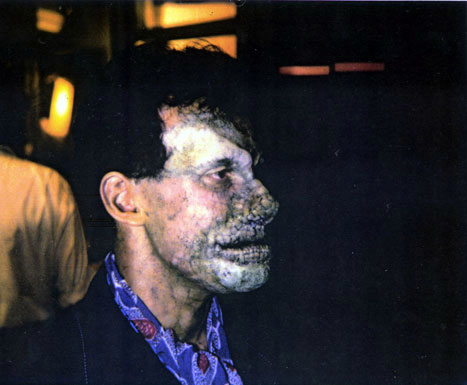
"I thought [the dino-human makeup] was very cool and wouldn’t have traded it for anything."
SA: What was your experience with the other lead cast and members of the production, including the directors and producers?
MC: It was pretty great, overall. I told my friends afterwards that I’d gotten paid to spend my summer vacation with Bob Hoskins, John Leguizamo, and Dennis Hopper. At the time, I didn’t know many people who could say something similar, so that was pretty cool. And everyone was really wonderful, especially Bob. Such a smart, warm, funny, approachable and real person. He’s a regular guy you can shoot the breeze with.
Also, working for Roland Joffe was a great thrill. I’d been a big fan of The Killing Fields and The Mission, and could not believe I got to hang out on a movie set with him every day. He was extremely friendly and generous. I used to lurk around the video monitors as much as I could to see how individual shots were framed and set up, and one day Roland noticed me looking over his shoulder and started explaining the nuts and bolts of framing and aspect ratios to me. I will be forever grateful for his generosity.
And I loved meeting all the other behind-the-scenes folks, as well. That was one of the mind-blowing aspects of the job: meeting these people who’d worked on movies I loved. Like Dean Semler, our cinematographer: he’d just won an Oscar for Dances with Wolves and had also shot The Road Warrior, a favorite of mine, so I was thrilled to work with him. And he remains, to this day, possibly the nicest person I’ve ever met in all of show business.
Doug, our camera operator, had worked on The Untouchables and Apocalypse Now, so he had some incredible stories to tell. Earl, the boom operator, had worked on most of Robert Zemeckis’s movies up to that point, so it was always fun talking to him. Plus, he and I were both movie trivia buffs, so we were always trying to stump each other. And our key grip, this guy named Chunky who was kind of like the movie crew version of Keith Richards, had worked on Return of the Jedi. Awe-some!
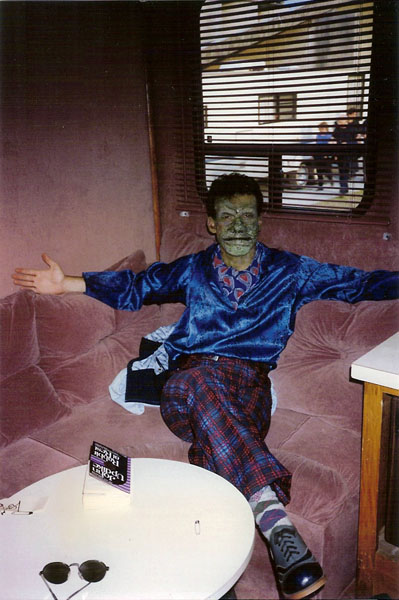
"That was one of the mind-blowing aspects of the job: meeting these people who’d worked on movies I loved."
SA: Overall, how was your experience? Despite the production's turmoil, we've heard from many people that it was a fun time for nearly everyone. How did your experience compare?
MC: I would say, overall, working on the movie was a valuable learning experience for me. Obviously, I met some incredible people, and I finally got a chance to work on a big-budget Hollywood movie. I will forever be grateful for both opportunities.
But, there was a lot of turmoil on the set, and I can’t say it was very fun for me. I was not as prepared for the day-to-day grind, the pressure, and the long hours as I thought I was. I also learned that I was perhaps a little too sensitive to work on a movie set. I did not have a very thick skin at the time, and movie crews are not known for their soft, diplomatic touches, especially under adverse circumstances like ours.
I feel like I probably took a lot of things personally that I shouldn’t have, but, hey, that’s where I was at the time. (Plus, I broke up with my girlfriend at the time about three weeks into the shoot, which was difficult and unexpected. Then, she ended up working on the movie and I was face-to-face with her every day for a few more weeks. We both made the best of it, but it was not easy.)
SA: What did you think of the movie when you first saw it?
MC: Honestly, I was disappointed in it when I first saw it. There were lots of weird, strange things we shot that didn’t end up in the film. There were also lots of little plot threads that didn’t quite make sense when we shot them, but I assumed those things would be cleared up and smoothed over when everything got edited together, but it seemed like that didn’t happen. The whole thing kind of felt like a missed opportunity to me. But, considering how much strife there was during the shoot, I’m not sure now that it would’ve been possible to salvage the movie’s potential after all was said and done.
SA: Can you remember what those weird, strange things were? We've heard about a lot of different sequences and establishing shots that were cut, but it's always interesting to hear about more.
MC: Honestly, it's been so long I hardly remember any of those particular details. I just remember that my copy of the script had so many different colored pages in it (indicated either revisions or additions) that I figured it'd take a miracle for the finished product to turn out cohesive in any way.
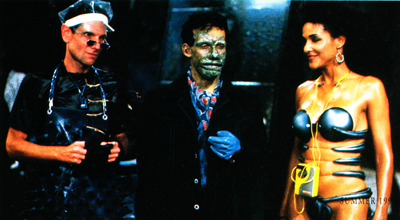
"There were lots of weird, strange things we shot that didn’t end up in the film."
SA: Which of the film's plot threads didn't quite make sense to you or the cast/crew? There are a few things in the story left unresolved or unexplored that we've heard the cast and crew didn't quite get or like, such as the fungus and the Bob-Omb.
MC: Yeah, the fungus and the Bob-Omb were both weird. But the thing that confused me the most was why Koopa's goons liked the theme from "Doctor Zhivago" so much. Where did that come from? Weird.
SA: Have you watched the movie since and, if so, has your opinion of it changed over time?
MC: I have not seen it since it first came out, but doing this interview – and learning about your website – is making me a little curious about re-visiting it. We’ll see.
SA: What are you up to these days?
MC: I’ve been doing a lot of theater in New York the past few years, mostly acting but also a little directing as well. I also had a stint as a theater critic for a few years before that. I still crank out an occasional piece of arts journalism.
And, I’ll be directing a new play here next winter, so I’m very much looking forward to that. Hoping to keep branching out more into directing, and possibly some creative writing too. I’m not really sure where this road is taking me right now, but I’m going to keep walking down it and see.
SA: Do you have any other interesting stories to tell or a message for us fans?
MC: There are many other stories to tell, but I don’t think there’s enough time and space for all of them. But, for all the fans of the movie, I would just like to say: thank you for being a fan of the movie. We worked like dogs on that thing, and it’s nice to know that someone dug it. So, thanks for that.
